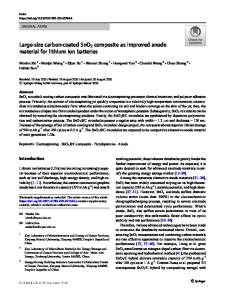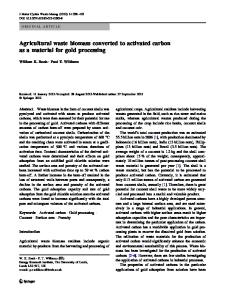Hard carbon derived from waste tea biomass as high-performance anode material for sodium-ion batteries
- PDF / 1,693,299 Bytes
- 8 Pages / 595.276 x 790.866 pts Page_size
- 16 Downloads / 398 Views
ORIGINAL PAPER
Hard carbon derived from waste tea biomass as high-performance anode material for sodium-ion batteries Linyuan Pei 1 & Hailiang Cao 1 & Liangtao Yang 2 & Peizhi Liu 1 & Min Zhao 1 & Bingshe Xu 1,3 & Junjie Guo 1 Received: 2 May 2020 / Revised: 22 June 2020 / Accepted: 27 July 2020 # Springer-Verlag GmbH Germany, part of Springer Nature 2020
Abstract Sodium-ion batteries (SIBs) with the advantage of low cost are attracting tremendous attention in large-scale practical application because of the abundance of Na resources. Nevertheless, the anode is still a great challenge in the development of SIBs. Herein, hard carbon derived from an abundant biomass of waste tea was prepared by a simple carbonization method. Meanwhile, the correlation between pyrolysis temperature and microstructure and the electrochemical properties of the as-prepared carbon materials were studied in details. The results indicate that the plateau capacity of these anode materials is closely related to carbonation temperature. Notably, the hard carbon sample pyrolyzed at 1400 °C presents the highest reversible specific capacity of 282.4 mAh g−1 and good rate capability, as well as excellent cycling stability with capacity retention of 83% after 200 cycles. Such hard carbon with promising electrochemical properties provides the chance to develop the less expensive sodium anode materials. Keywords Biomass carbon . Anode material . Sodium-ion batteries . Long life cycling
Introduction The increasing interest for high-performance and low-cost energy storage systems (ESSs) has been drawn by new energy sources, such as solar, tidal energy, and wind [1, 2]. Among the most widely used ESSs, lithium-ion batteries (LIBs) have been successfully employed as power sources for consumer electronics and electric vehicles due to their high energy density and adequate cycle life [3, 4]. However, the limited resource of lithium severely restricts their large application, which has caused growing concerns to develop new rechargeable energy storage systems. Recently, sodium-ion batteries * Hailiang Cao [email protected] * Junjie Guo [email protected] 1
Key Laboratory of Interface Science and Engineering in Advanced Materials, Ministry of Education, Taiyuan University of Technology, Taiyuan 030024, China
2
Department of Chemistry, Humboldt-University Berlin, Brook-Taylor-Str. 2, 12489 Berlin, Germany
3
Materials Institute of Atomic and Molecular Science, Shaanxi University of Science & Technology, Xi’an 710021, China
(SIBs) are receiving broad research interests as a complementary candidate for application in grid energy storage because of the abundant reserve of sodium and its similar chemical and physical properties to lithium [5, 6]. Yet, the ionic radius of sodium is little larger than that of lithium, resulting in slow ion diffusion kinetics during Na+ intercalation into the electrode [7, 8]. In addition, theoretical research suggests that the large sodium ion cannot intercalate into graphite due to the small interlayer distance [9
Data Loading...











